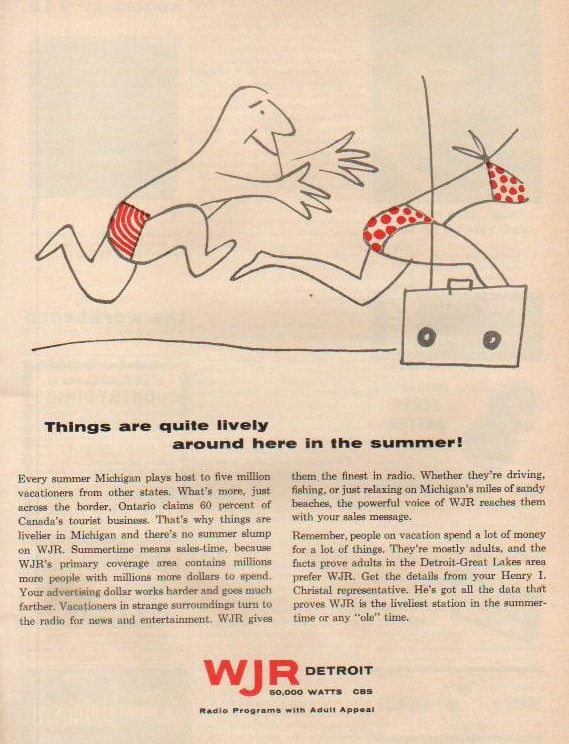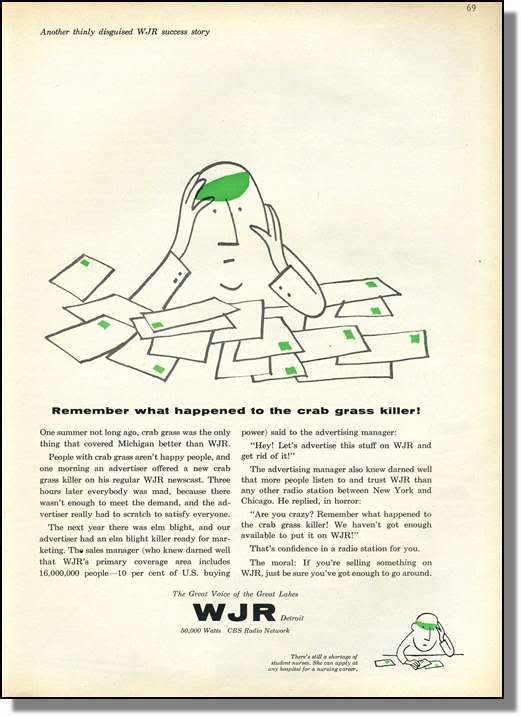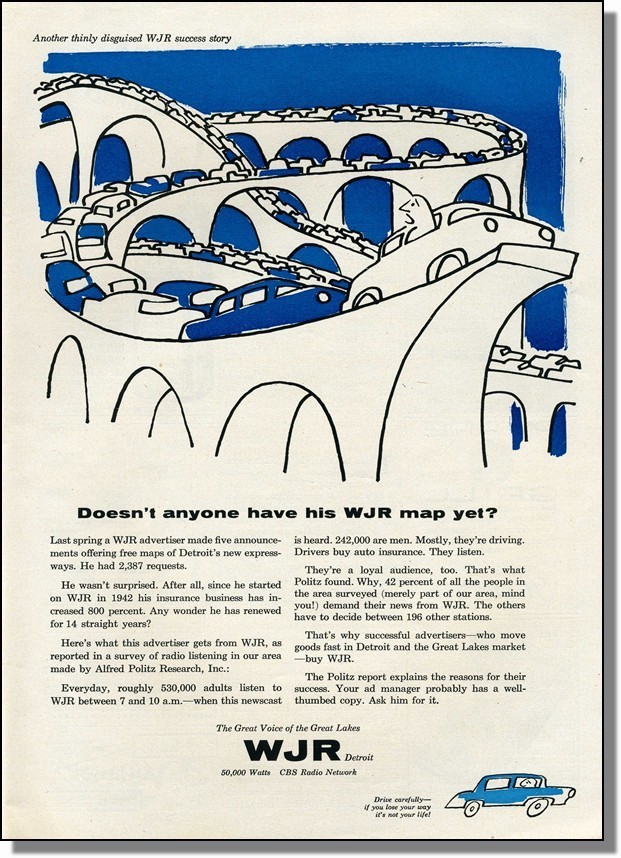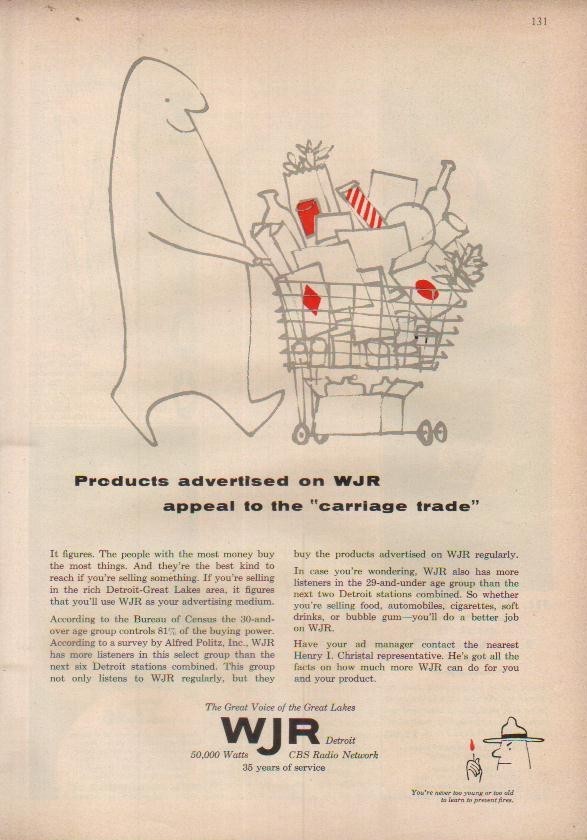![]()
Category: WJR
WJR 1958: THINGS ARE QUITE LIVELY AROUND HERE IN THE SUMMER!
ANOTHER THINLY DISGUISED WJR SUCCESS STORY: 1955
ANOTHER THINLY DISGUISED WJR SUCCESS STORY: 1956
ANOTHER THINLY DISGUISED WJR SUCCESS STORY: 1957
ONE OF A KIND RADIO STATION: DETROIT’S WJR-AM 1966
http://www.youtube.com/watch?v=BxswozcNZnw
MCRFB note: This film promo, presented here in three installments, was produced by the WJR radio sales department exclusively for advertisers in 1966. The film was introduced by famed radio news broadcaster Lowell Thomas. Film narrative by J. P. McCarthy. (Also, you may view the entire 22 minute film, uninterrupted, in the bottom frame).
![]()
THE GREAT VOICE OF THE GREAT LAKES — LEAVING DETROIT? . . . JANUARY 5, 1985
 From the MCRFB NEWS archive: 1985
From the MCRFB NEWS archive: 1985
Motor City Outcry Changes WJR/WHYT Moving Plans

DETROIT — WJR/WHYT are staying put, to the great delight of the Motor City. Public outcry following the stations’ announcement last spring that they would be moving to nearby Troy after 62 years in Detroit was so great, according to WJR/WHYT president and general manager Ron Pancrantz that “management decided the station won’t relocate.”
The announcement came (recently last) December 5, the same day the Detroit City Council passed a unanimous resolution urging the Detroit radio landmark to stay in the city, says WJR promotion director Diane Taylor.
According to Taylor, the 50,000 watt clear channel station has been broadcasting from the art deco Fisher Building since May 4, 1922. Capitol Cities Broadcasting of New York bought the AM/FM combo in 1964 for $21 million and has remained as owner ever since.
Last spring, WJR management announced that the station would be moving 10 miles north to suburban Troy, sometime in 1985. The strong public reaction against the proposed move, coupled with the FCC’s initial rejection of their application — due to too much distance between headquarters and transmitter — caused the station to reconsider.
According to general manager Pancrantz, the FCC’s preliminary ruling against the move “was not a major factor in the decision. Our attorneys had told us we could convince the FCC to approve our move. But it is the outpouring of the public and Detroit city officials that convinced us we should respond to the city’s invitation to explore other locations.”
The lack of needed space for station headquarters has not changed, says station promotion director Taylor, but a new location is now being sought within Detroit city limits. END
___
(Information and news source: Billboard; January 5, 1985)
![]()
COUNTRY MUSIC MAKING STRIDE, CKLW ON TOP . . . SEPTEMBER 18, 1971
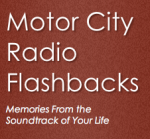 From the MCRFB NEWS archive: 1971
From the MCRFB NEWS archive: 1971
J. P. McCARTHY NO. 1 IN MORNINGS; WDEE NO. 3 IN DETROIT: PULSE REPORT APRIL/JUNE 1971
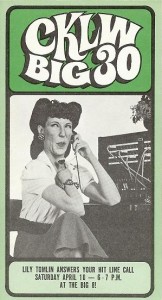 DETROIT — Country music seems to be doing well in Detroit where WDEE is third in the market 6 A.M. through midnight in the April/June Pulse. CKLW and the Paul Drew pack is No. 1 with 19, WJR comes in with a 17 and nobody touches J. P. McCarthy in the mornings: this guy has a 21 from 6-10. Across the board, WDEE, programmed by John Mazur, has a 7, 8, 6, and 3 (through hours 6-10 A.M.) Breaking the other stations down CKLW has 17, 20, 21 and 14. WABX-FM has 2, 3, 4, 6. WKNR has 3, 3, 6, 5. WRIF-FM has 0, 1, 2, 3. WCHB was pulsed with 4, 4, 5, 10. END
DETROIT — Country music seems to be doing well in Detroit where WDEE is third in the market 6 A.M. through midnight in the April/June Pulse. CKLW and the Paul Drew pack is No. 1 with 19, WJR comes in with a 17 and nobody touches J. P. McCarthy in the mornings: this guy has a 21 from 6-10. Across the board, WDEE, programmed by John Mazur, has a 7, 8, 6, and 3 (through hours 6-10 A.M.) Breaking the other stations down CKLW has 17, 20, 21 and 14. WABX-FM has 2, 3, 4, 6. WKNR has 3, 3, 6, 5. WRIF-FM has 0, 1, 2, 3. WCHB was pulsed with 4, 4, 5, 10. END
___
(Information and news source: Billboard; September 18, 1971)
![]()
WJR-AM RETURNS TO THE CBS RADIO NETWORK… JANUARY 12, 1963
 From the MCRFB NEWS archive: 1963
From the MCRFB NEWS archive: 1963
After More Than 3 Year Absence, WJR Returns to the CBS Network

DETROIT — After a three-and-a-half-year separation, powerhouse WJR has rejoined CBS Radio, thus filling a glaring gap in the network’s nationwide coverage and adding more CBS “names” to the station’s own extensive personality roster.
The move has spelled no radical change so far in WJR station personnel, though much program shifting has been necessitated by the addition of such shows as “Arthur Godfrey Time,” Art Linkletter’s “Houseparty,” the “Garry Moore Show,” Betty Furness’ “Woman’s Word” and dozens of CBS News programs.

Biggest move slices Jim Wood’s popular afternoon broadcast of “Showcase,” an easy-going blend of pop music, album instrumental tracks, interviews, from a daily two hours and 15 minutes, cut down to 50 minutes across-the-board. Most of the lost time is being made up, however, on a new “Jim Wood Show,” from 10:05 to 11:00 P.M. The new program includes some of the “Showcase” ingredients with the addition of humorous skits written and enacted by the ‘man-of-many-voices’ Wood.
The long-time WJR music variety show, “Guest House,” has been torn down after nine-years as an evening program landmark, but re-appears almost intact as “The Bud Guest Show” in the 12:30 P.M. through 12:55 P.M. slot, featuring host Guest and the WJR orchestra led by Jimmy Clark. The shift, meanwhile, has knocked out a WJR music-oriented show, “Time Out For Music,” which will now be heard on Saturdays only.
Popular WJR air-personality J. P. McCarthy, considered by record industry personnel as being the Motor City’s top-rated record-spinner, has lost his Saturday afternoon segment of “Music Hall,” but has an extra 15 minutes tacked onto his late-afternoon into early-evening daily stint. His early morning spot is left as unchanged from Monday through Saturday.
A 50,000 watt, clear-channel station, WJR covers more radio homes than any station outside of New York, Chicago and Los Angeles — 15,500,000 people in four States plus an additional 3,000,000 in Canada. One of the nation’s pioneer stations, WJR began broadcasting in 1922 and has since become Detroit’s premier good-music radio station.
WJR has been a CBS affiliate from September, 1935 through May, 1959, when station management split with the network over the new Program Consolidation Plan. The Program Consolidation Plan (or PCP) involved compensating affiliates with free programing which they could sell to local advertisers, rather than paying the station cash for using network programming.
Cash Is Back

Dallas Townsend; Robert Trout; Stuart Novine; Jerry Coleman; Richard Hottelet; Alexander Kendrick; Douglas Edwards; George Herman; Winston Burdett; Leonard Berstein (pictured left).
Arthur Godfrey; Allan Jackson; Art Linkletter; David Schoenbrun; Betty Furness; Garry Moore; Nancy Dickerson; Charles Collingwood; Lowell Thomas; Chris Schenkel (pictured right)
Stations consider it as an unworkable “barter” system, declared it would hurt the industry and gave the network its six-months’ contractual notice. The plan was dropped by CBS early this year and cash compensation was restored, paving the way for this week’s return.
Since the schism, the CBS Radio Network had been without a regular outlet in the important Detroit market. The NBC outlet of longstanding is WWJ, the Detroit News station. ABC owns and operates WXYZ and WKMH programs Mutual news and sports shows.
Commenting on the move back to WJR, CBS Radio President Arthur Hull Hayes said, “We welcome the re-affiliation of WJR because it reflects the renewed vigor and indestructible importance of (CBS) network radio” having now been enjoined once again in the Detroit market. END
___
(Information and news source: Billboard; January 12, 1963)

![]()
AIRCHECK OF THE WEEK: REMEMBERING CLARK REID
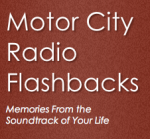 A MCRFB salute to a great Detroit radio legend: Clark Reid
A MCRFB salute to a great Detroit radio legend: Clark Reid
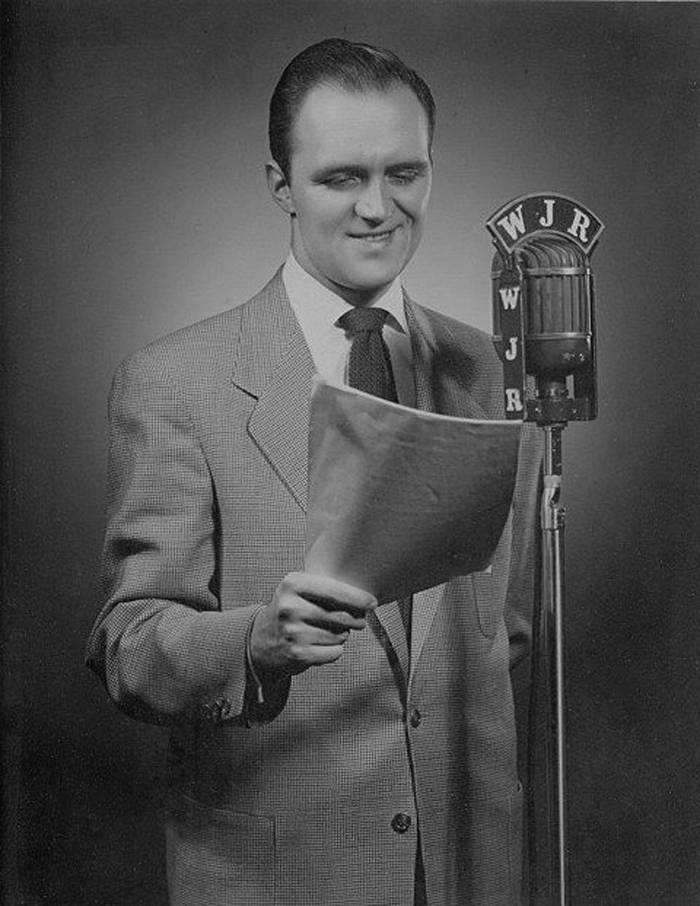
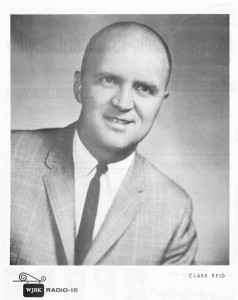
Clark Reid on WJR-AM 760 and WJBK-AM 1500 (Click on for audio play)
…Well, Jimmy Durante is still funny — television, they got them every place you go. No one listens to radio anymore. You sit in saloons and watch television. …
A long time ago in the early 1950s, there was WJR. And then there was WJBK. And there he was. Clark Reid earlier on WJR and later on WJBK radio here in Detroit.
Clark Reid. A name as enigmatic as WJBK. A name as synonymous as to what classic Detroit radio was all about, as it were, during the 1950s through the early 1960s here in the Motor City.
Clark Reid introduced himself to Detroit radio way back in 1952, when he first opened the studio microphones on local CBS-affiliate WJR. New in town at the time, Clark made his way north into Detroit from Akron, Ohio. Formerly from Akron’s WAKR, Clark once held the distinction of having replaced the legendary Alan Freed on that station, who moved over to Cleveland’s WJW to launch his legendary “Moondog” shows.
At WJR, Reid was first hired as a personality for the all-night show. While the station’s day-part policy was strictly delegated sustaining CBS network programming and local community fare, Clark was given complete control and freedom in selecting whatever music he wanted to play, so long as it was from the extensive record library at WJR.
One of the highlights of his early days at WJR was on Thursday nights when Reid was doing his “all-request” shows. With the station’s towering 50,000-watt signal, letters of requests would pour in from all over the country. It was “an important show to get a record played on,”Clark once said, as he was constantly “chased by not only by record promotion men, but also the ‘song pluggers.'”
Many of the recording stars who performed in Detroit clubs during those days found their way into the WJR studios. Some of the most popular artists became over-night “guests” on his all-night shows. It was of no consequence that on any particular night, names such as Sammy Davis, Jr., Johnny Ray, Nat King Cole, Rosemary Clooney, Eddie Fisher, Peggy Lee and many others appeared courtesy his shows, which Clark once described as resembling a “Tonight Show” on radio, for the most part, during the four years he was there. Clark recalled once that, “it was just a great experience on WJR because I had complete freedom to do whatever I wanted to do.”
But in late April 1956, Clark Reid made the switch over to WJBK for the morning drive.
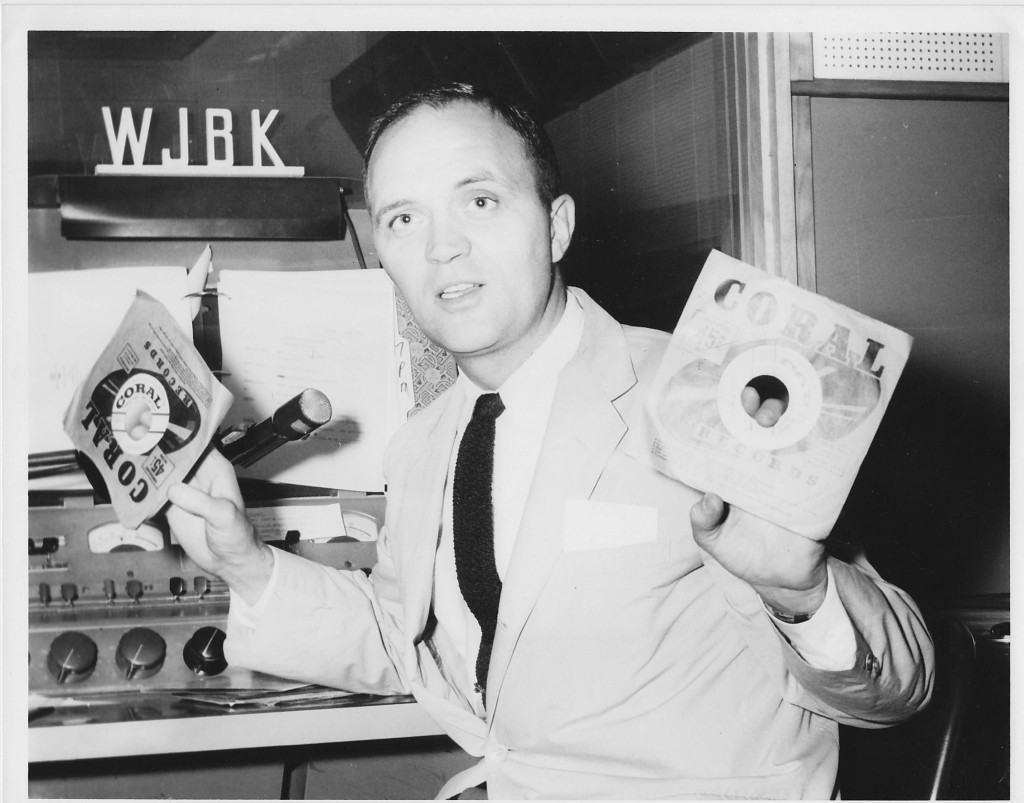
Clark was hired from WJR by WJBK Station Manager Harry Lipson immediately after WJBK fired Mickey Schorr, Schorr eventually found his way over to market-competitor WXYZ. At the same time, WJBK decided to move their morning team of Joe Gentile and Ralph Binge for the evening hours instead, while Clark Reid took over reigns as the new host for the morning show on Radio 15.
When he began his early tenure at WJBK, Reid was there working alongside with the legendary Ed McKenzie. Ed McKenzie had been at WJBK since 1937. At the time of Reid’s hiring, Ed was still broadcasting under the moniker “Jack the Bellboy,” a banner McKenzie christened unto himself when he first assumed that title a decade earlier in 1945. Also at WJBK in 1956, Reid was in good company with a new deejay that was “up-and-coming” there. His name? Casey Kasem.
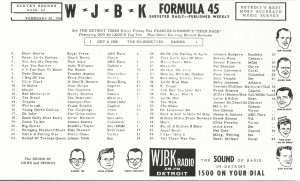
While at WJBK, the station had made the switch going with the Top 40 sound in late 1956. Their new program director, Bob Martin, changed the station’s long playlist to “Formula 45,” which became the station’s catch phrase for the music they played, not just rock and roll, Elvis and Little Richard, but also hits by the Four Lads, Perry Como, Gogi Grant and Pat Boone as well. WJBK was one of the very first major market playing Top 40 in the country then, along with sister-station WIBG, another Storer-owned station in Philadelphia at the time. Eventually, Clark Reid was given the honors hosting the “Formula 45” weekly record countdown, heard every Saturday morning on “the new” WJBK.
It was by then that Clark Reid’s sudden rise in popularity had been well established as a Motor City “favorite” on the dial. He was now center-stage on WJBK and Reid’s radio legacy would continue to flourish during the rest of his broadcasting career here in Detroit.
But after a string of successive years of Top 40 radio on WJBK, from 1956 through 1963, Detroit’s “Radio 15” was closing in on it’s best days, soon to be mirrored in it’s legendary past.
In March 1964, the impact of WKNR’s sudden rise to the top had drastically altered the market picture in Detroit. By July 1964, then in quick decline both in ratings and revenues, WJBK was no longer able to compete going against WKNR, CKLW and WXYZ as well, losing a ten-month battle to regain a larger market share. In the end, the Storer Broadcasting Company decided to dump WJBK’s Top 40 sound for a more conservative, music format they would phrase as the “Sound of (Just Beautiful) Music.”
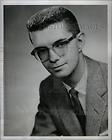
WJBK’s program director at the time, John Grubbs, stated at the time that “a majority of the people polled are desirous of the type of format we will be launching in August. WJBK’s ‘Sound of (Just Beautiful) Music and Total Information News’ is being designed to incorporate all members of the staff.”
According to Billboard’s May 16, 1964 Radio Response Rating for Detroit, WQTE and WWJ both reported conservative music formats. WCAR and WJR, meanwhile, featured music of the standard variety, culled primarily from albums played. Despite the change of format implemented suddenly at Radio 15, Grubbs was of the belief that, “our air personalities are all top pros and are capable of handling any format (changes).”
WJBK staffers included Marc Avery, Robert E. Lee, Robin Walker and Bobby Layne. And then there was “The Sound of Just Beautiful Music.” The new format change on WJBK took effect on a Sunday morning, August 16, 1964.
Many years ago, Clark had remarked in a trade article that the new format change, “came out of nowhere and I was just devastated. One day we were playing the Beatles and Motown, then, all of a sudden, they had us cuing instrumental cuts by 101 Strings.”
Apparently, the immediate music change would not bode well with Clark Reid. He would remain at WJBK for only a few more months. By early 1965 Clark had removed himself away from the station. He would journey many miles away to Cleveland’s KYW-AM. But the move to Ohio, ultimately, would be the final phase Clark would play out of his legendary broadcast career.
By year’s end in 1965 Clark Reid was back home in Detroit. But this time, as a representative for the Ross Roy Advertising in Oak Park, MI, where he culminated a very successful career with the ad agency for many years thereafter, until his retirement in 1991.
WJBK Clark Reid Jingle 1962
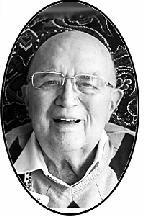
On February 3, 2012, Clark Reid passed away at his home in Novi, MI., surrounded by family. He is survived by his wife Barbara, his wife of 63 years; children Cathy, Jody, David, Libby, and Tim Reid, and his eleven grandchildren.
A memorial service was held at 11 a. m. on Saturday, February 25 at Nardin Park Methodist Church at 11 Mile west of Middlebelt in Farmington Hills.
MCRFB once again pays homage to a great Detroit radio legend as we remember . . . Clark Reid.
MCRFB would like to express our sincere gratitude to Tim Reid for donating the Clark Reid photograph (top) and aircheck for this exhibit. Clark Reid photograph and WJBK survey scan is courtesy the George Griggs collection. The Clark Reid photograph (lower) courtesy of Michigan.com.
![]()

